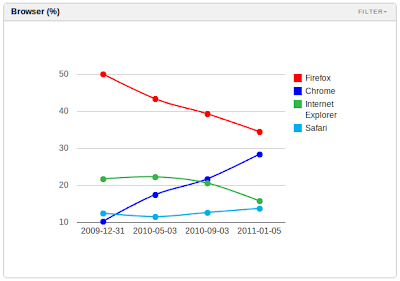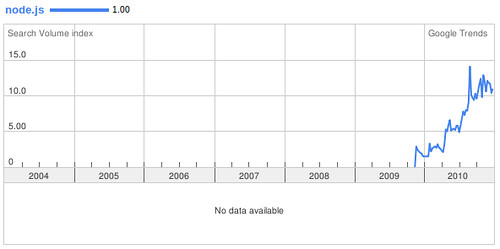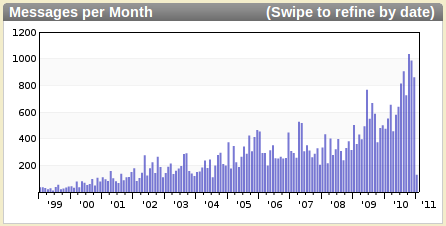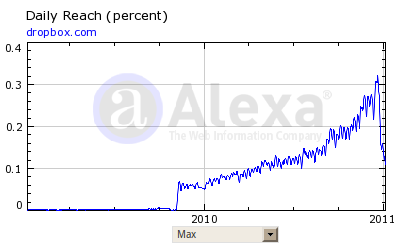It is true that predictions for the new year are best made before it begins. And predictions regarding consumer technology trends specifically should certainly be made prior to CES. All fair complaints.
Which I will now ignore.
The following are my predictions for the upcoming calendar year. They are informed by historical context and built off my research, quantitative data that’s available to me externally or via RedMonk Analytics, and the conversations I’ve had over the past twelve months, both digital and otherwise. They cover a wide range of subjects because we at RedMonk do.
With respect to their accuracy, as with all predictions these are best considered for what they are: educated guesses. For context, last year’s predictions graded out as approximately 66% correct.
On to the predictions.
Browsers
Firefox Will Cede First Place to Chrome, But Not Without a Fight
 |
| From Screenshots |
We built RedMonk Analytics to track developer behaviors, and what it is telling us at present is that Firefox and IE both are losing share amongst developer populations to Chrome. Chrome is highly performant, but also benefiting from significant marketing investment (e.g. billboards, site sponsorships) and related product development (e.g. Chrome Web Store). The conclusion from this data is that Chrome will eclipse Firefox from a marketshare standpoint (speaking specifically of developers, not the wider market where Firefox is sustainably ahead), likely within a quarter.
But having tested the 4.0 version of Firefox for several weeks, it’s clear that Mozilla’s browser is responding to the evolutionary threat. Firefox 4.0 is faster and less stale from a user interface perspective, but more importantly differentiated via features like Panorama.
The 4.0 release is unlikely to be sufficient in preventing Chrome from assuming the top spot among developer browser usage, but it is likely to arrest the free fall. Expect Chrome and Firefox to be heavily competitive in 2011.
Cloud
PaaS Adoption Will Begin to Show Traction, With Little Impact on IaaS Traction
The conventional wisdom asserts that, at present, the majority of cloud revenue derives from IaaS offerings over PaaS alternatives. The conventional wisdom is correct. Infrastructure-as-a-Service has benefited from its relative simplicity and by virtue of its familiarity: IaaS offerings more closely resemble traditional infrastructure than PaaS. Platform-as-a-Service adoption, for its part, has been slowed by a variety of factors from legitimate concerns regarding platform lock-in to vendor design decisions. The result has been a marketplace that heavily advantages IaaS.
This will not invert in 2011, but the wide disparity in relative adoption will narrow as PaaS adoption climbs. With a multiple year track record of of anemic adoption, PaaS vendors will adapt to customer demand or they will lose ground. Specifically, expect PaaS vendors to borrow from Heroku’s model [coverage], offering platforms assembled from standard or near standard componentry.
Assuming that PaaS will never be successful because it has yet to be successful is illogical. Historical precedent demonstrates adequately that some markets take longer to establish than others (e.g. SaaS). Watch PaaS in 2011.
Interestingly, the rise in PaaS adoption will have little impact on Amazon. Most obviously because its traction has become, to some extent, self-fulfilling, but also because the vendor has anticipated demand and added platform-like features to its infrastructure offerings. With cloud being far from a zero sum market, it’s reasonable to expect Amazon and select PaaS vendors to both be successful.
Developers
Talent Shortages Will Continue
It is counterintuitive to speak of talent shortages when the overall labor market hovers near 10% unemployment, but the data supports no other conclusion. Employers that we speak with, large and small, are desperate for people. RedMonk Analytics query histories regularly feature searches on named individuals, a frequent precursor to recruiting efforts. Our @monkjobs account, for its part, has more positions that we can reasonably post.
It is unclear where this demand will lead. Fred Wilson is correct when he argues that the fundamentals of this hiring war are unsustainable in the longer term. But even should the hypercompetitive Silicon Valley market experience a major correction, it is probable that wider industry trends will remain biased towards talent, assuming the economy does not substantially recede in the next twelve months.
What this means, then, is that employers will be forced to be creative about talent acquisition. Besides traditional benefits such as high end workstations and stock options, employers may be forced to consider allowing employees to release their work as open source, granting them access to data not available elsewhere or giving them the right to work relatively autonomously within the larger organization. In many cases, it may involve leaving positions unfilled in favor of consumption of externally produced software. Other counterintuitive approaches to easing hiring pains include publishing guidelines on your proprietary engineering approaches (e.g. Hadoop), which affords some of the benefits of open source software – namely academic familiarity – without the attendant risks to competitive advantage.
Expect hiring to be a challenge in 2011. If identifying and employing qualified resources proved challenging during the worst recession since 1930, it is unlikely to become less so as global economies gradually recover.
Frameworks
Node.js Will Continue its Growth Trajectory
Of all of the technologies we tracked in 2010, none generated the same interest that node.js did. Using RedMonk Analytics to rank the incoming developer queries from January 1st, 2010 to December 31st, 2010, node took the top two spots on our list. Nor is our experience unique: Google Trends reflects the same spike in traffic.

We expect this to continue. Node.js is not just another framework; it’s a fundamentally different way of approaching challenges like concurrency that limit even moderately sized properties today. Couple this with the ascendancy of Javascript and the aggressive evolution of the V8 stack and we see no reason to expect Node.js to plateau.
Data
Much of what I would predict in this space has already been said, better. O’Reilly’s Edd Dumbill, for example, expects data marketplaces to come of age in 2011. Given that we expected data to emerge as a revenue generating asset in 2010, we concur. And both Edd and Hilary Mason predict substantial data related job volume expansion, and thus a tight labor market. Again, we are in agreement. But here are two predictions for what we expect to see in data.
Firms Will Increasingly Seek to Leverage the Data They Generate
With the cost of storage falling in response to declining memory prices as well as the introduction of commodity hardware and software, organizations have greater capacity for telemetry capture. They also have an increased ability, via open source software, to leverage this data in new ways. Better and more accessible big data technology is enabling entirely new lines of inquiry. As a result data which was once considered a byproduct becomes an asset, economically speaking.
Predictably, this is causing friction between business and IT. Business is more cognizant of the value of their data by the day, but traditional IT departments which are less familiar with the emerging class of big data tools are hitting the brakes on putting it to work. Patience with this tactic is exhaustible, however. Lines of business will have their results, whether they have to go outside the organization or not.
We will undoubtedly see more public data made available, as Hilary predicts, and more private data sold, as Edd anticipates. But we will also see organizations become introspective in search of internal, high value data.
Hadoop Will Become the MySQL of Big Data
This is already arguably true, but by the end of 2011 there will be no argument. Much as MySQL emerged as the dominant player among many candidates for the lightweight backend to websites large and small, Hadoop is becoming the de facto standard platform for Big Data. While Hadoop’s MapReduce and distributed filesystem implementations are already effectively the standard outside of proprietary alternatives, its extensibility is what will prolong its longevity. Hive and Pig bring SQL-like interaction to the store, while projects like Hbase bring to Hadoop GFS-like key-value store capabilities.
There are undoubtedly shinier proprietary technologies (e.g. Dremel, Percolate), but Hadoop’s market presence will be cemented in 2011.
Hardware
- Desktop:
Workstations Will Make a Comeback:
For all the talk of machine availability driven by the cloud, most of the developers I know – particularly those who play in big data spaces – are rotating away from MacBook Pro-style portable hardware to workstation-class hardware. When you’re operating on large datasets or virtualizing multiple operating systems, the combination of outsized display, fast processor and large memory footprint makes life easier. Laptops will not die out, in spite of the coming tablet wave, but they will be less primary in their role moving forward. - Servers:
ARM Will Emerge as a Server Player:
It may seem obvious in light of the news that Windows will run on ARM and Nvidia’s Project Denver, but the growing importance of ARM has been apparent for months now. Speak with hardware suppliers, and they will all privately admit that they’re experimenting with ARM based server designs. Software development trends, meanwhile, reflect this. Observe the spike in ARM discussions on the primary Linux development mailing list in 2010.
From Screenshots Doubtless a majority of the conversations center around mobile architecture and design, as Android and other projects have driven Linux on ARM into consumer markets in volume. But the attraction of the platform, most particularly in power consumption, don’t end in mobile.
It’s not clear to me that Nvidia’s ambitions of realizing ARM markets in consumer desktops will meet with success, but the evidence for a significant server presence is there.
- Tablets:
Tablets are a Real Market:
There’s speculation in some quarters that tablets are a passing phenomenon. I do not subscribe to this view. Tablets are, at present, seriously limited by input mechanisms. But they excel in other areas. The Motorola Xoom tablet, as an example, is claiming 10 hours of battery life displaying video. More important is the anecdotal evidence that machine usage patterns seem to be changing. If workstations become more common and use of laptops as workstations declines, there’s a natural market for lightweight, portable machines. Particularly for those who need to demo things.
Mobile
Challenges of Native Development Will Drive Interest in HTML5 and Hybrid Approaches
The inevitable product of multiple successful mobile development platforms is a fragmented development landscape. Further complicating the development process is the challenge of navigating competing marketplace options. Enterprises privately express frustration with the status quo, and even developers are questioning the efficiencies of reimplementing the same application for multiple platforms. As a result, expect cross platform approaches such as HTML5 and hybrid-compilation solutions such as PhoneGap to attract more interest as the challenges of supporting the Android tablets that will begin arriving in Q1, Windows Mobile, and so on become more acute.
NoSQL
There are many relevant trends in the NoSQL space worth discussing, but two predictions that can be made with a reasonable degree of confidence are:
- The NoSQL Marketplace Will Experience Consolidation:
We’re in the beginning stages of a cycle which is likely to output a handful of successful projects. Much as the relational database market cannot support an infinite number of comparable projects, the NoSQL space will begin to contract from its 2010 height as technically credible but not popularly adopted projects are supplanted by competitors. - NoSQL Will Look More Like Pro-SQL:
One of my original objections to the NoSQL term was its implicit rejection of a widespread, well understood technology in SQL. The limitations imposed by this designation have been clear to a variety of projects, which in turn have led to the reintegration of features common to traditional RDBMS systems but typically omitted from first generation NoSQL stores. These include indexing and, ironically, SQL access. NoSQL stores will remain differentiated from relational alternatives moving forward, but less so than they were in years past. We’ve seen this trend play out, before, remember, with MySQL. The enterprise tension requires projects to walk a fine line [coverage].
Open Source
- Open Source of Non-Strategic Infrastructure Assets Will Increase
Historically, businesses that developed software have considered it a differentiating asset, one worth protecting. Over time, many of these in house development efforts have given way to packaged applications. An insurance company, for example, is unlikely to develop Customer Relationship Management software that’s superior to what an open market can provide. While this is widely understood and accepted, open source software is not yet viewed in the same context.This is changing. Intelligent enterprises are increasingly aware of the lack of differentiation that infrastructure software provides, and are therefore rethinking the economic model for software development. If software is non-differentiating, the benefits to making it publicly available may easily offset the cost of maintaining it internally [coverage]. Such is the logic that has led to the release of projects like Cassandra, Hadoop, and Hbase.
Expect to see more of this moving forward, as the benefits to open development become more obvious and the anticipated downside proves to be less than substantial.
- Forking: How Development Gets Done
Development, historically, has been a serial activity. A developer passes changes to another developer who adds to the codebase and so on. The advent of version control systems such as Subversion made this process more efficient, but didn’t really alter the dynamics. Distributed source code management technologies such as Git or Mercurial, however, enable a concurrent, parallel development that has more in common with bacterial replication than centralized version control.Networked implementation of these toolsets such as Github have fundamentally and permanently altered the nature of development [coverage]. This approach has become so common, in fact, that where once open source projects would do everything in their power to discourage forking, today their websites actively incite it (see below).

In 2011, then, forking won’t be a curiosity: it’s how development will get done. Most frequently on network-backed implementations on Github.
- Ubuntu is the New SuSE
It was six years ago last November that we first speculated on the possibility of IBM supporting its applications on a Debian based distribution. Last year, this became reality for two reasons. First, because Canonical was more aggressive in embracing greenfield opportunities on the cloud than its competitors, who were myopically focused on their customers; customers who were collectively well behind the curve. But just as important has been the end of Novell [coverage]. For all of Attachmate’s promises to give SuSE the support it needs to continue servicing its install base, the market has already largely reacted away from the acquired entity in favor of, primarily, Canonical’s Ubuntu.Red Hat will maintain a firm grip on the commercial Linux distribution lead as a result of its consistent performance and excellent account control, but Ubuntu will emerge as the de facto alternative at the expense of SuSE.
Programming Languages
James stated this perfectly: at one point, learning Javascript meant you were not a serious programmer. At this point, not learning the language makes the same statement. Javascript is resurgent, and buoyed by the V8 runtime and adjacent frameworks like Node.js will expand its footprint on the server.
Bonus
The mistake often made with Dropbox is its categorization as merely another synchronization application. All of the quantitative data available points to a larger opportunity. Alexa, for example, shows Dropbox’s growth trajectory.
 |
| From Screenshots |
Google Trends, meanwhile, shows a more pronounced 2010 spike in interest:
 |
| From Screenshots |
This growth is driven by a variety of needs. The most basic is simple backup or cross-platform file availability. But underlying most of these behaviors is a more subtle realization: Dropbox is a virtual, cross-platform filesystem for a substantial and influential population. Whether you use a MacBook and an iPad, Windows and a Blackberry, or Ubuntu and Android, as I do, your filesystem is available. This is particularly important for device types – smartphones and tablets, primarily – that don’t natively expose their own filesystem. Dropbox doesn’t message this, but features like the shareable links for music are an indication of the possibilities to an abstraction of the filesystem that not only spans devices but that can be exposed via a browser.
The net of this growth and its drivers is that Dropbox will become an attractive acquisition target. Expect Apple, Google and Microsoft to be among the interested parties. Acquisition scenarios are likely to be challenging, however, not just because of the potential competition for the asset, but because Dropbox is relatively successful in monetizing usage. The data available does not support prognostications of a specific exit, then, but it does indicate that those discussions will accelerate in the coming year.

Recent Comments